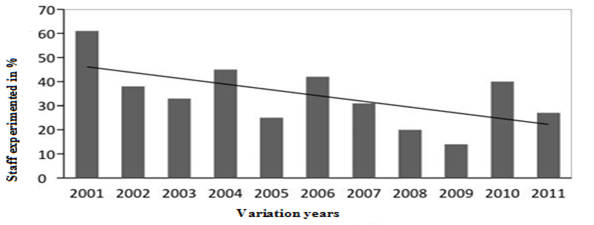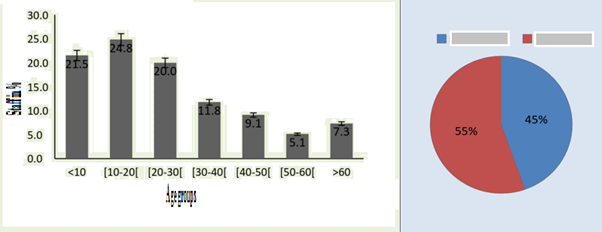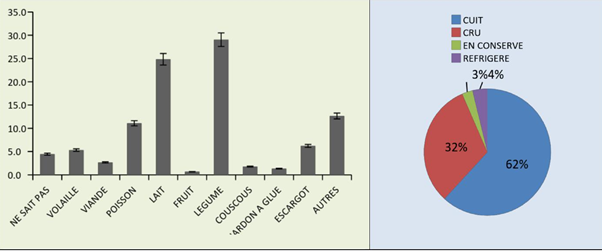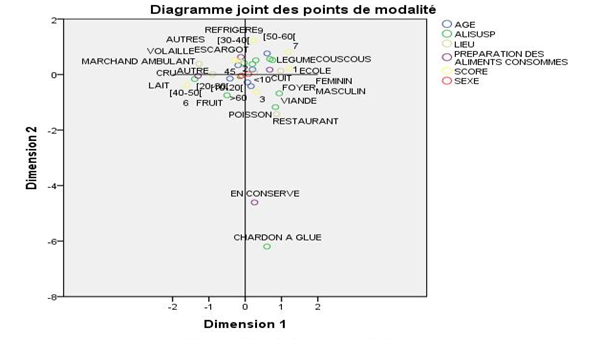Research Article
Volume 1 Issue 5 - 2017
Retrospective Study of the Collective Food toxi-infections in the Region of the GharbChrardaBni-Hssen, Morocco of 2001 to 2012
1Higher institute of the Nursing and technical Occupations of Health, Kenitra
2genetic Laboratory and Biometrics, Ibn Tofail University, Kenitra
2genetic Laboratory and Biometrics, Ibn Tofail University, Kenitra
*Corresponding Author: Belomaria M, Higher institute of the Nursing and technical Occupations of Health Kenitra, Morocco.
Received: August 25, 2017; Published: September 13, 2017
Abstract
One of the essential characteristics of our region is undoubtedly the socio-demographic characteristics which reveal a rural population, the majority of which have a literacy rate. To verify such assumptions the surveys carried out following the declaration of these outbreaks. The relative files consulted included data on the number and characteristics of the individuals affected the severity of the cases (hospitalization, death), the food in question, the organism involved and factors that might have contributed to their occurrence.
A total of 69 outbreaks were reported from 1 May 2001 to 31 August 2012 in the region of Gharb ChrardaBni-Hssen, which reported 451 patients. 72.7% were reported by the emergency services. The annual change in the number of reported Collective food toxic-infections was marked by an annual fluctuation in the number of outbreaks between 3 and 9 households. Fruit and vegetables top the list of food contaminants. The use of contaminated raw materials was responsible for 30.9%. The identified causative organisms are limited to Clostridium perfringens and Staphylococcus aurous. The latter was isolated in 42 outbreaks, while Clostridium perfringens was isolated in 27 outbreaks.
Keywords: Epidemiology; Toxic-infections; Food, Collective; GharbChrardaBni-Hssen
Introduction
In a region where the gastronomy is a queen, the food dresses, doubtless more than somewhere else, a quite particular importance. Yet, whenStaphylococcus and Clostridium invites itself to the menu, the good small dishes seem sometimes very difficult to digest.
In the region of the GCBH, the strategy of promotion of the food hygiene gives another considerable priority to the institutional and commercial catering. The households do not benefit from the interest yet which we should give them; nevertheless, the meals are usually private within the family unit (the restoration is before a matter of the domain of the private individual).
A reflection was recently hired to sketch the main lines of a regional strategy of prevention of the TIAC. It is obvious that such a strategy will be centered on the promotion of the food hygiene within the households for actions of information, educational and of communication. At the beginning, he was considered useful to lead an investigation. In collective environment, the collective food toxic-infections are not rare. Their statements are widely under estimated by the sanitary authorities. Their origin is rarely clarified because of the weakness of the ways of in particular bacteriological diagnosis. [1] Very often, the first cause called by the local persons in charge is «the poisoning ", source of deep passions at diverse levels of the community (organizers of festivities, village headman, mayor or other authorities).
Therefore, the information is strikingly delayed even much distorted when the opinion of the Doctor is requested. It is then asked to him to discover the origin of the food contamination and, in the event of death, to place the responsibilities. This task is not easy, requiring necessarily a meticulous epidemiological survey allowing the medical persons in charge to pronounce.
The statements of TIAC in the region of the GCBH emanate from the service public health and epidemiological surveillance. It is obvious that the available data do not reflect the real epidemiological situation as far as they are far from being exhaustive.
Indeed, our monitoring system of the TIAC based on the compulsory statement still suffers from money statement and many homes of TIAC go unnoticed. This phenomenon is not moreover appropriate to our region.
Besides, the quality of the data resulting from epidemiological made inquiries. During the arisen of TIAC, is still satisfactory because the investigations are not led still for the reasonable deadlines notably because of the late statements.
In the region Gharb Chrarda Bni-Hssenin North Western Morocco the underlying causes at the origin of these poisonings are very varied, going ecological disturbances to the human fraud via the food habits and the hygienic factors. The requirement of the consumer, the omnipresence of the media and the business competition urged the sanitary authorities to place the sanitary safety of food to the rank of the priorities. By watching to assure hygiene and harmlessness of food "of the fork in the fork".
The organized measures aim, first and foremost, at avoiding the food poisonings for a maximal safety of the citizen and in the second to set up devices of traceability of products to being able to remove food contaminated by germs or by toxic products every time a threat is suspected.
High prevalence of the TIAC allowed us to study the epidemiological profile of the collective food toxic-infections in the region of GharbChrarda Bni-Hssenin North Western Morocco during the period 2001-2012.
It is an exhaustive retrospective study on the TIAC which were declared to the provincial hospital of Kenitra during the period going from 2001 till 2012. We exploited the registers of the SIAAP of the delegation of health. We held diseases to compulsory declaration only. The relative consulted files contained data concerning the number and the characteristics of the affected people, the gravity of the cases, the incriminated food, the germ in cause and the factors which would have been able to favor such homes.
Results and Discussion
451 cases of poisonings were notified in the region of Gharb between 2001 and 2012. The analysis of the cloud of points shows that, between 2001 and 2011 (Face 1), the number of poisoned cases decreases according to the years (r = - 0, 61; p ≤ 0, 05), this can be bound to the sanitary education, the information, the communication regarding food hygiene and the awareness of the citizen of the social and economic incidence, in particular the work stoppage, the repressive measures against companies and restaurants in cause.
The institutional catering would require a regular follow-up and in particular homes having presented the TIAC before. It is necessary to be aware that every declared TIAC limits its worsening. The efforts supplied by the authorities of the Ministry of Health, by developing the system of epidemiological investigation and of investigation, would explain, maybe, the very remarkable increase of the number of poisoned cases declared during the year 2012 (75 cases).
The distribution of the sample according to the sex shows that 55% of the poisoned are of the female sex and 45 % are of the male sex, distributed in 69 episodes. The distribution of the sample according to the age groups shows that the majority of these poisonings involve however the working population including the teenagers and the adults (Face 2). Indeed, 66, 3% of the poisoned are less than 30 years old, 26 % have an age between 30 and 60 years and 7, 3% have more than 60 years old.
The distribution of the places of the poisoning showed that 68% had arisen in the family home, 6% to the restaurant, 5% in peddlers, 2% at the school and 17% did not even know where they were incriminated (Face 3). However, the size of homes varied according to the type of home. The average number of sick by home was 6 in family circle and 8 in community. The most important home arisen in family circle concerned 20 people and in community 17 people. In Mars 2008, 11 pupils were victims of a food poisoning.
The most frequent food in cause was vegetables and fruits 29%, the milk and the dairy products 25%, fishes 11%, poultry and eggs 5, 3% and snails 6%. 8% of the poisoned did not even know the causal food. 62% of these contaminated food were consumed in the cooked believed consummate state and 31%. While 7% of this incriminated food were in the conjoint state and/or cooled (Face 4). Indeed, these contaminations could of essentially in tracks of toxic biological or chemical residues of order.
Face 4: Percentage of CFTI by types of incriminated food and the nature of preparation of the food (2001-2012).
The analysis of the hierarchical tree of the various clinical signs appeared to the sick cases just after the poisoning showed two different classes:
*The first class is established by the usual clinical signs (diarrhea, nausea, abdominal pains, vomiting), * the second class groups the rest of the clinical signs such as (excessive thirst, excessive salivation, fever, shivers ….)
*The first class is established by the usual clinical signs (diarrhea, nausea, abdominal pains, vomiting), * the second class groups the rest of the clinical signs such as (excessive thirst, excessive salivation, fever, shivers ….)
The global analysis of the various clinical signs expressed in the form of total score showed that 68, 5% of the sick developed between 2 and 4 signals and 7, 5% presented no symptom. The most frequent signs are the ones, generally, of the first one class. And which appear at more than 50% of the sick: diarrhea (52%), nausea (47%), abdominal pains (68%), vomiting (55%), and shivers (24%). Vegetables represent the incriminated food which cause most going symptoms until 9 clinical signs, followed besides.
Food (milk, meat, etc.) which talk between 2 and 6 signs. The test Khi-deux of Pearson has shown a strong connection between these two factors with a coefficient of contingency of 0, 63 (Khi two = 305, 77; p 0,000). Indeed, the severity level thus depends on the nature of the consummate food.
The analysis of factors having contributed in her arisen TIAC shows that 38% are due to contaminated raw materials, 22% in the contamination by the environment of the staff and 22% in the contamination by the environment of the equipment, 6% is due to the failure to respect the statutory temperatures, 6 % is due to the deadline mattering between preparation and consumption, 6% are due to an error in the preparation and of the consumption
Global analysis of variables
| Poultry Meat | Fish Milk | Vegetable | Couscous | Snail | Khi-two de Pearson | Significance | ||||||||||
| Diarrhées | 0 | 9 | 9 | 37 | 30 | 63 | 5 | 14 | 52,193a | ,000 | ||||||
| 1 | 15 | 3 | 13 | 82 | 67 | 3 | 14 | |||||||||
| Nausées | 0 | 4 | 8 | 36 | 60 | 71 | 0 | 10 | 44,600a | ,000 | ||||||
| 1 | 20 | 4 | 14 | 52 | 60 | 8 | 18 | |||||||||
| Abdominales | 0 | 0 | 5 | 30 | 20 | 38 | 5 | 9 | 64,946 | ,000 | ||||||
| 1 | 24 | 7 | 20 | 92 | 93 | 3 | 19 | |||||||||
| Shivers | 0 | 24 | 11 | 50 | 67 | 103 | 8 | 26 | 72,052a | ,000 | ||||||
| 1 | 0 | 1 | 0 | 45 | 28 | 0 | 2 | |||||||||
| Vomitings | 0 | 14 | 10 | 39 | 12 | 66 | 184 | 134,313 | ,000 | |||||||
| 1 | 10 | 2 | 11 | 100 | 65 | 0 | 14 | |||||||||
The agent responsible of the TIAC notified was confirmed by takings of human origin (saddles, blood and others) besides the clinical and epidemiological data. In, 72 % of the cases it is the Staphylococcus aureus and 28 % Clostridium perfringens. On a national scale on 1577 cases of TIAC in 2001, 96 cases are confirmed due to the bacterium salmonella and 259 cases can be probably awarded to him. In the region of Gharb, the salmonellosis essentially owed to the animal contamination of the food of origin are rare for the benefit of the contaminations of hydric origins (fruits vegetables, milk etc.). The pond of Sebou isrecognized for its pollution upstream and its repercussion on the agriculture downstream. [2]
Main normalization of the variable
This poisoning would have important aftereffects especially on the children of less than 10 years from 50 to 60 years old and the people. Other group is characterized by the poisonings due to the generally believed consummate food such as the milk and the exposed food sold by the peddlers. This type of poisoning reaches the working population of the elderly from 20 to 40 years old.
Nevertheless, the data of this study on the TIAC in the region of the GCBH represent an important base which could be enriched over the years and which we can exploit to direct our prevention initiatives. So, this study has the merit to clear certain peculiarities of the TIAC in the region of the GCBH. We shall hold, in particular, the ascendancy in the rural area and the family spaces with an average size of the homes of 6,7personnes, a rate of 52 % hospitalization and no lethality.
In fact, the epidemiological situation of the TIAC in our region does not seem to be very different from that besides of the country. On the other hand, in most of the developed countries the situation seems to be different. The eating habits of our population are characterized by a growing appeal to the industrial preparations of the meals and to the institutional catering which occupies from now on a part, more and more important, within the food habits of these companies, where from a medicalization more pronounced by the TIAC.
In our country, it is possible that the statement of the homes of CFTI is better thanks to a better raising awareness to this problem on behalf of the various participants in the domains of the food safety. The morbidity bound to the CFTI seems to be very worrisome in the region of the GCBH.
However, considering the lack of exhaustiveness of the available data, at present, we have to interpret this situation with caution. There is good reason to strengthen our monitoring system of the CFTI and to improve the performances so as to clarify better the epidemiology.
Besides, the investigation of the homes of declared TIAC should be led with more obligatorily and for the reasonable deadlines using appropriate epidemiological approaches and benefiting from the contribution and from the support of the laboratory every time it impossible. It is that at this price that we shall obtain reliable, useful data and usable to direct our prevention initiatives and better refine our regional strategy of promotion of the food hygiene, he would be thus fundamental to have reliable epidemiological data to mark out the main components of a program concerning the healthiness of food [3].
But already and taking into account data of this study, we could opt for a strategy of compatible prevention with the peculiarities of the region, directed mainly to the space family and targeting especially the rural and semi-urban areas.
The actions to be begun should be centered on the education of the households which should benefit from the contribution of the media and from the intervention of the associative fabric to become soaked with educational messages concerning the observation of the regulations of food hygiene. The implementation and the regular follow-up of these activities will be combined in a strengthening of Health control at the level of the urban areas of the region implying especially the surveillance of mass consumer foodstuffs. [4]
Our study is the unique in Morocco; because by consulting the literature concerning the TIAC we were in confrontation with a lack of Moroccan bibliography, what we urged to look in the Tunisian and French bibliography.
Also during our search to archives, there was problem in gathering the index cards of investigation which was 4 pages, so we developed an index card in a page besides an electronic index card.
For a speed on the feedback and for a management of the alerts, we used the software Wintiac. With more precision while widening the field of sampling through all the Moroccan regions and by moving on ground, we can improve the working methodology [5], this we shall allow to identify with advantage the collective problem of food poisoning.
References
- http://www.sciencespo-toulouse.fr/servlet/com.univ.collaboratif.utils.LectureFichiergw?ID_FICHIER=3837.
- Bouchrif B., et al. “Lutte et prévention des toxi-infections alimentaires à Salmonelles. 1er symposium de Virologie au Maroc”. Marrakech (2003).
- BORNERT G., et al. “Method of veterinary investigation during toxi- collective food infections in the armies: balance sheet of 28 homes declared between 1999 and 2000. Medicine and Armed 30.7 (2002): 575-580.
- POLVECHE Y., et al. “hygiene in military institutional catering, reality, untruths and unspoken”. Current event Health 57 (2000):14-17.
- MORILLON., et al. “Screening of the carriers of salmonella spp. among the staff of the restoration. Economic and bibliographical study. Medicine and Armed 35.2 (2007): 141-146.
Citation:
Belomaria M and Khadmaoui A. “Retrospective Study of the Collective Food toxi-infections in the Region of the GharbChrardaBni-
Hssen, Morocco of 2001 to 2012”. Nutrition and Food Toxicology 1.5 (2017): 198-204.
Copyright: © 2017 Belomaria M and Khadmaoui A. This is an open-access article distributed under the terms of the Creative Commons Attribution License, which permits unrestricted use, distribution, and reproduction in any medium, provided the original author and source are credited.








































 Scientia Ricerca is licensed and content of this site is available under a Creative Commons Attribution 4.0 International License.
Scientia Ricerca is licensed and content of this site is available under a Creative Commons Attribution 4.0 International License.